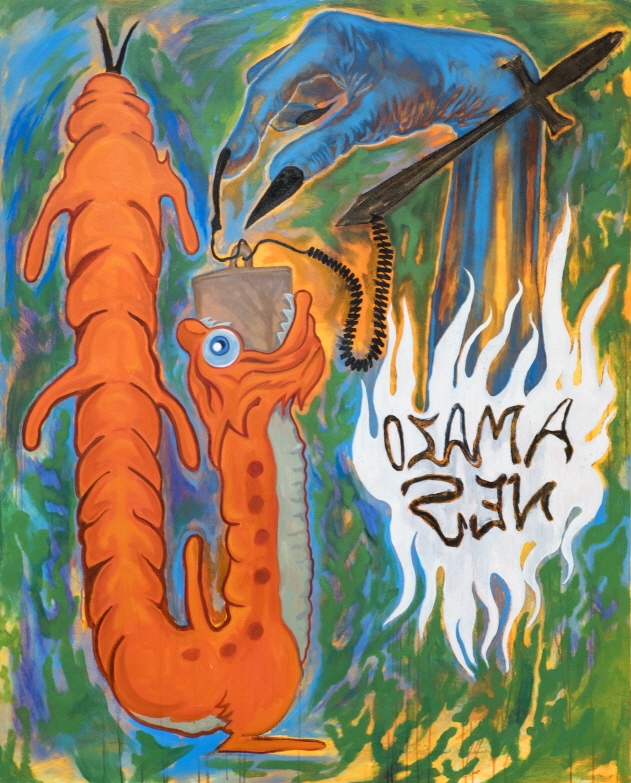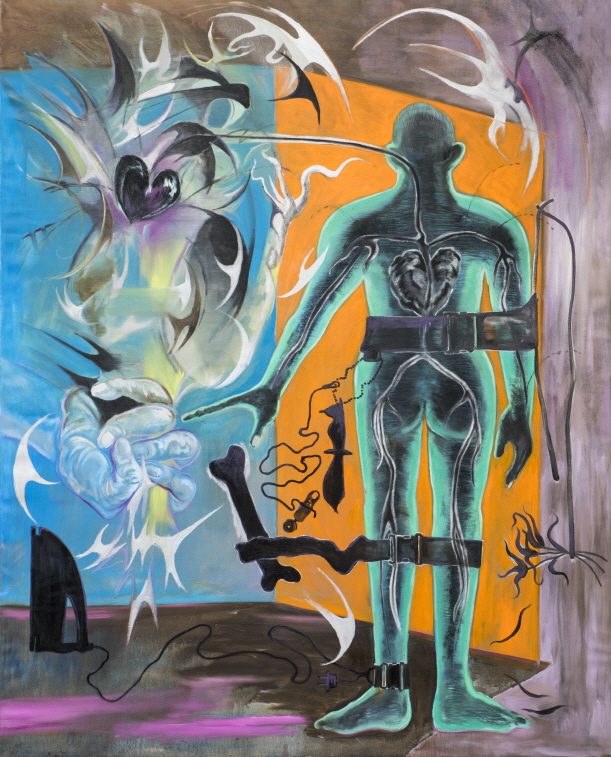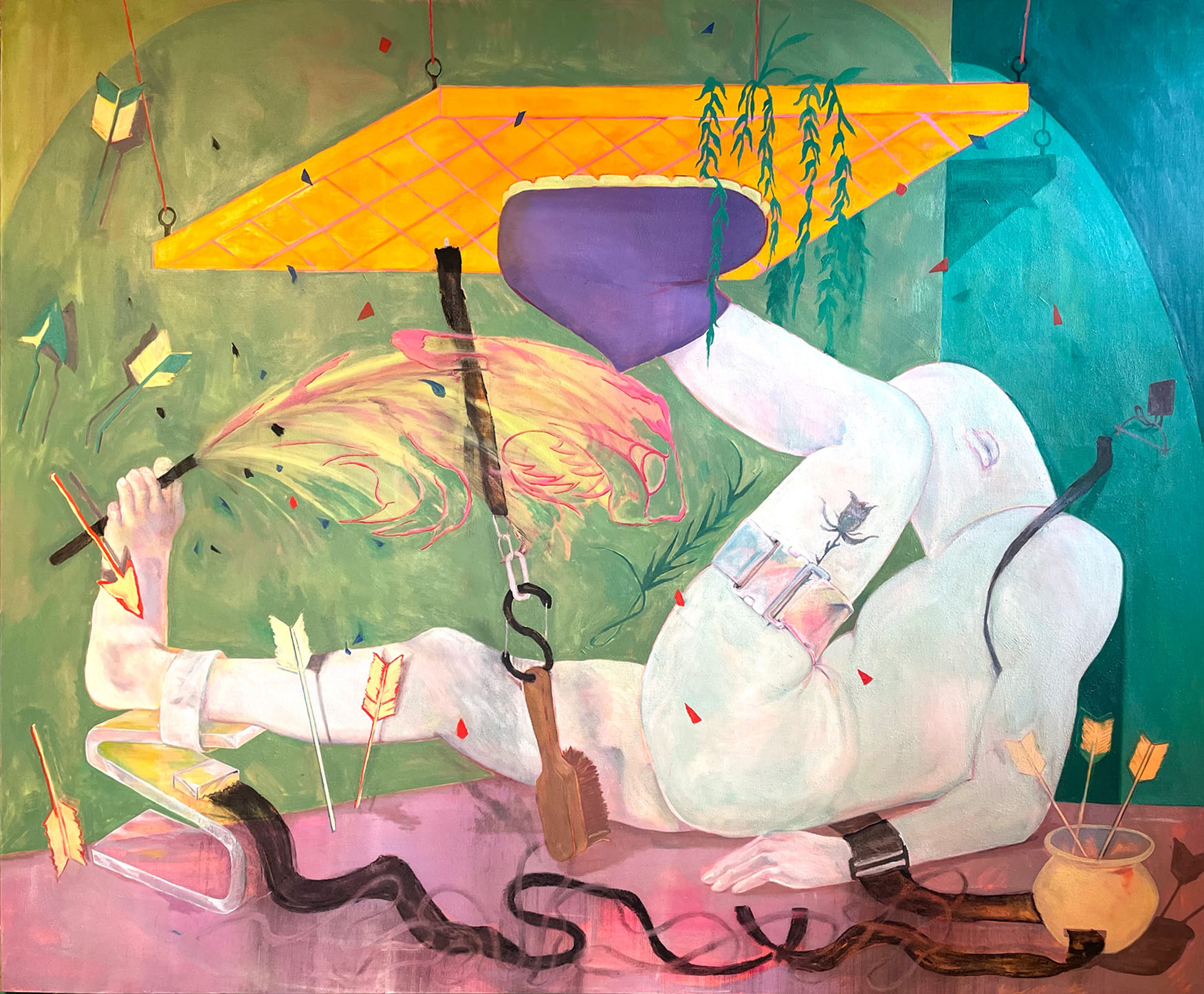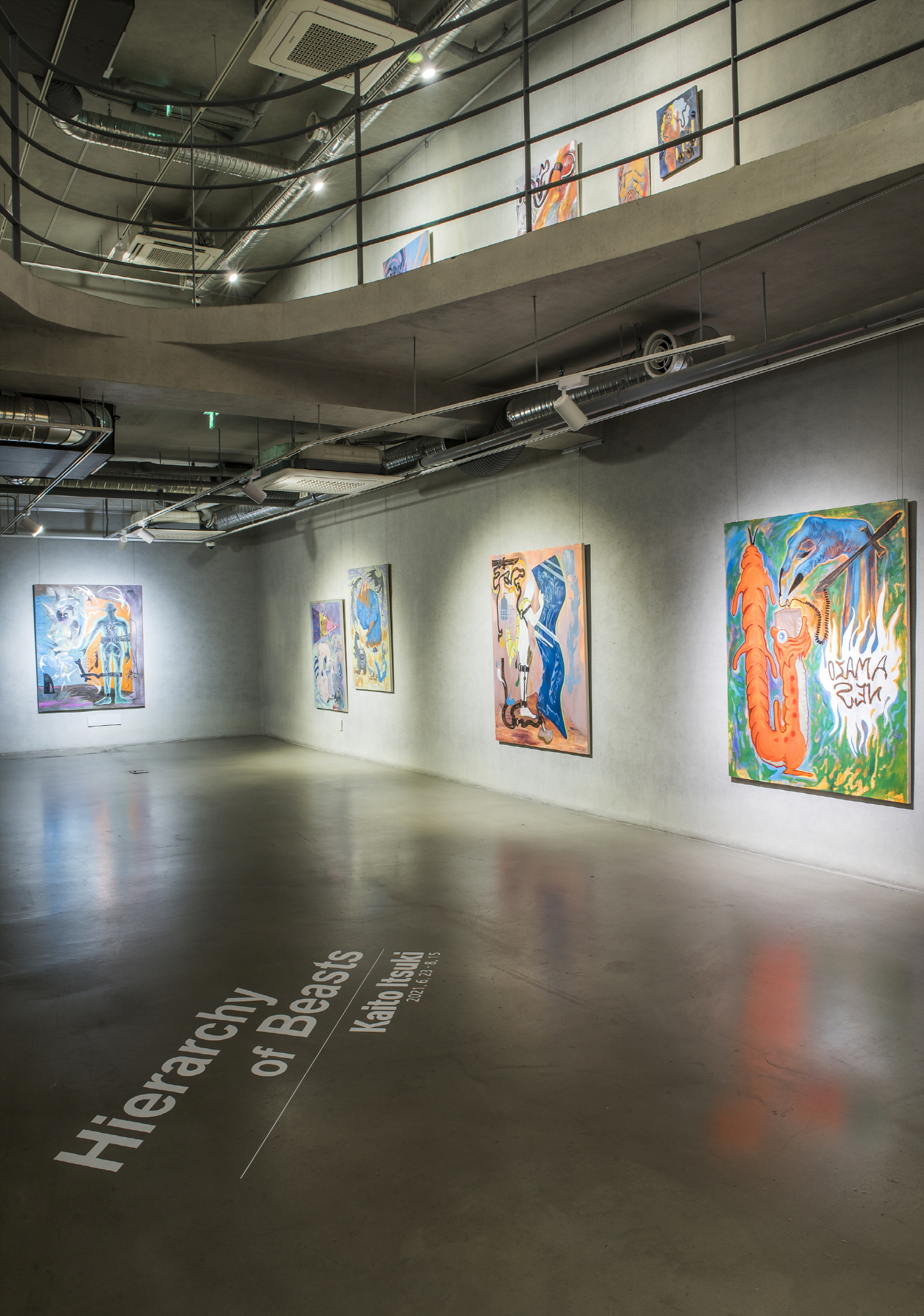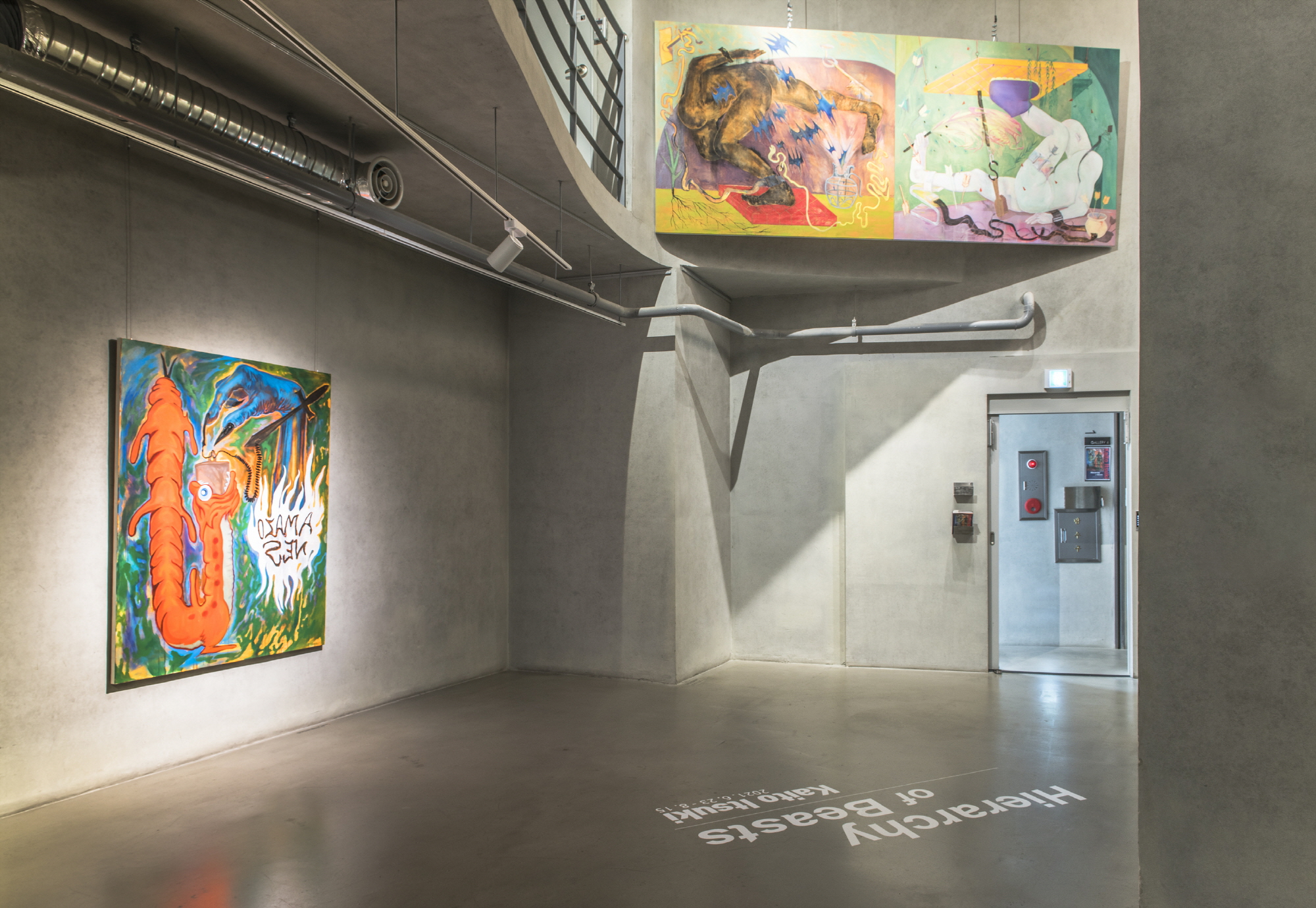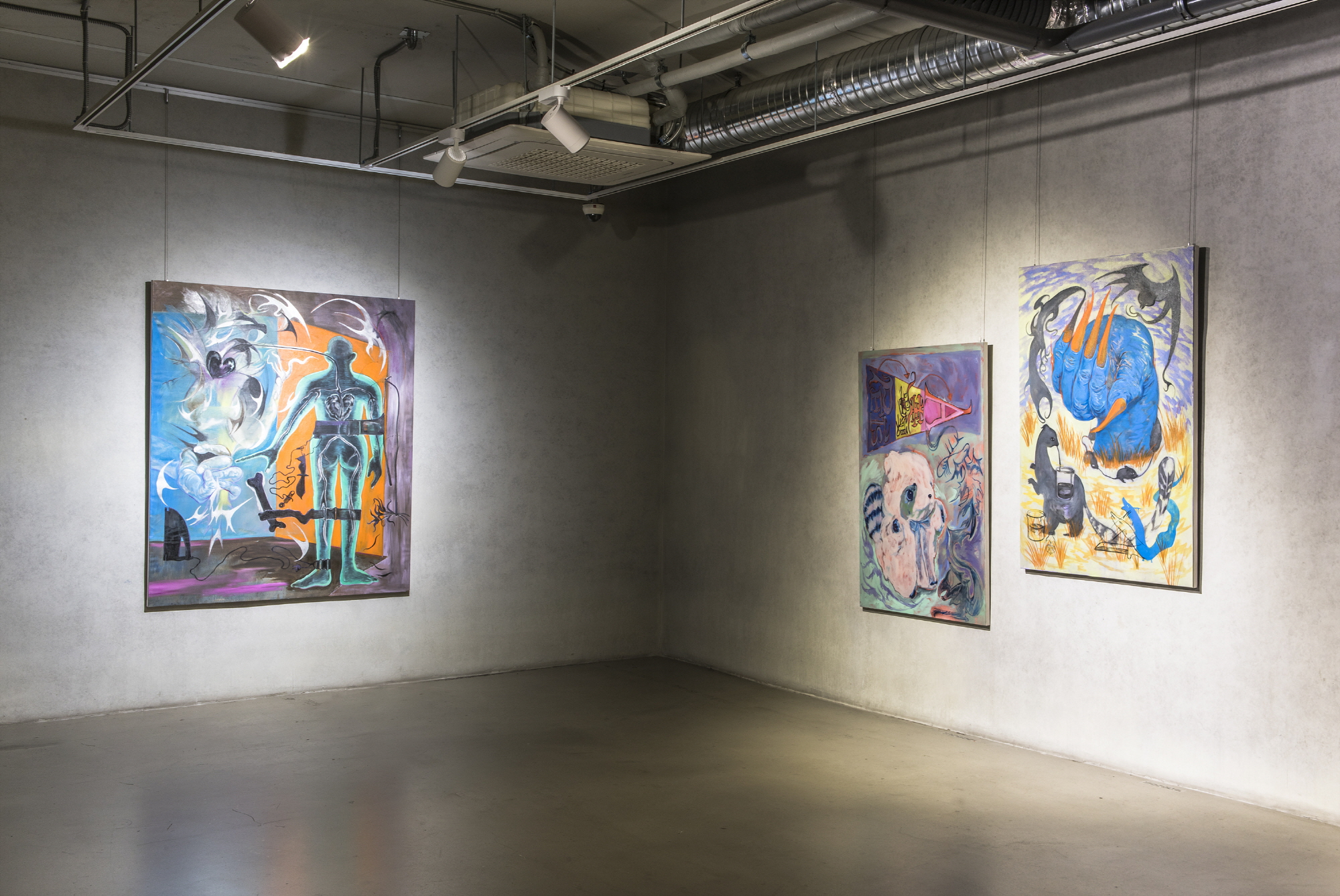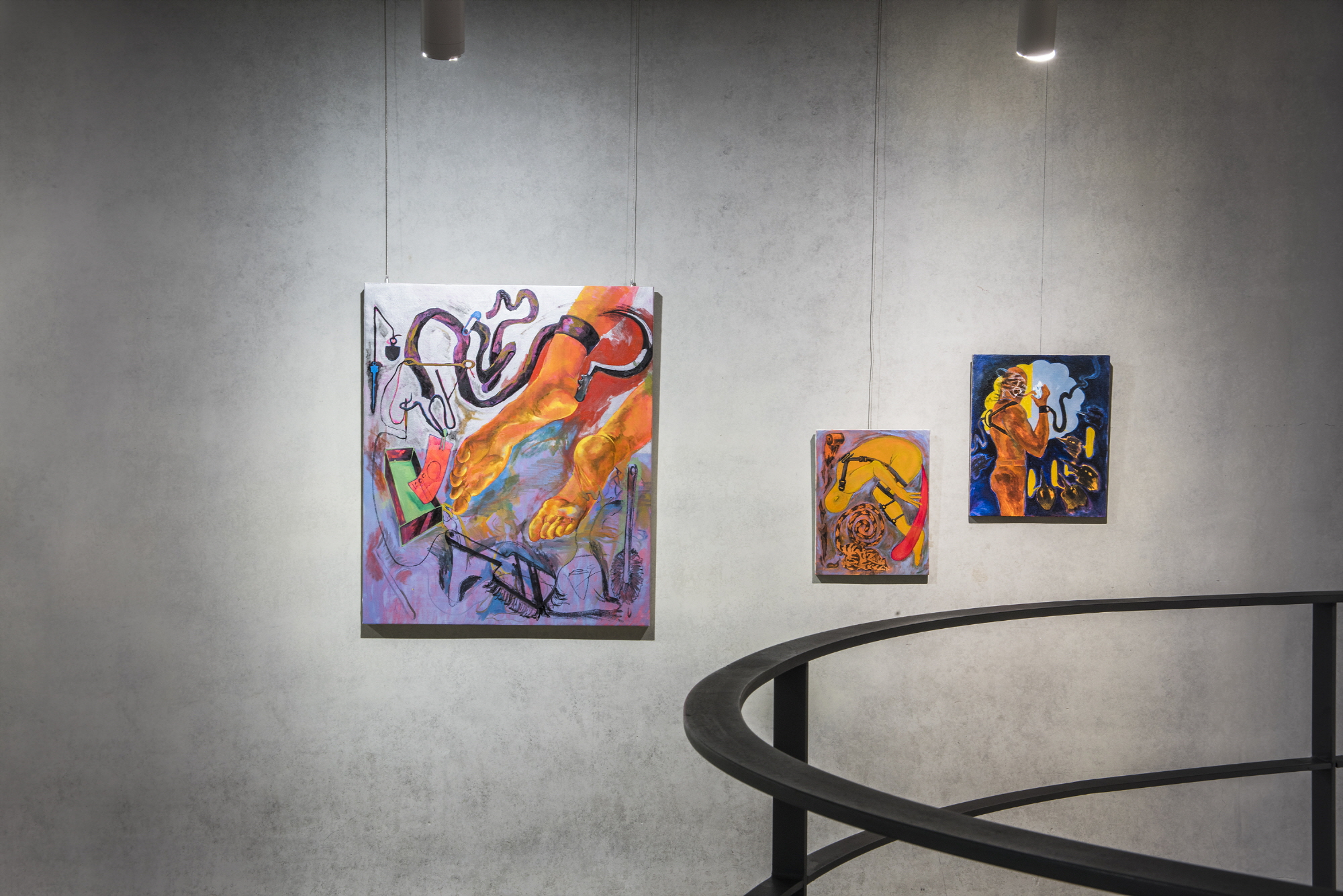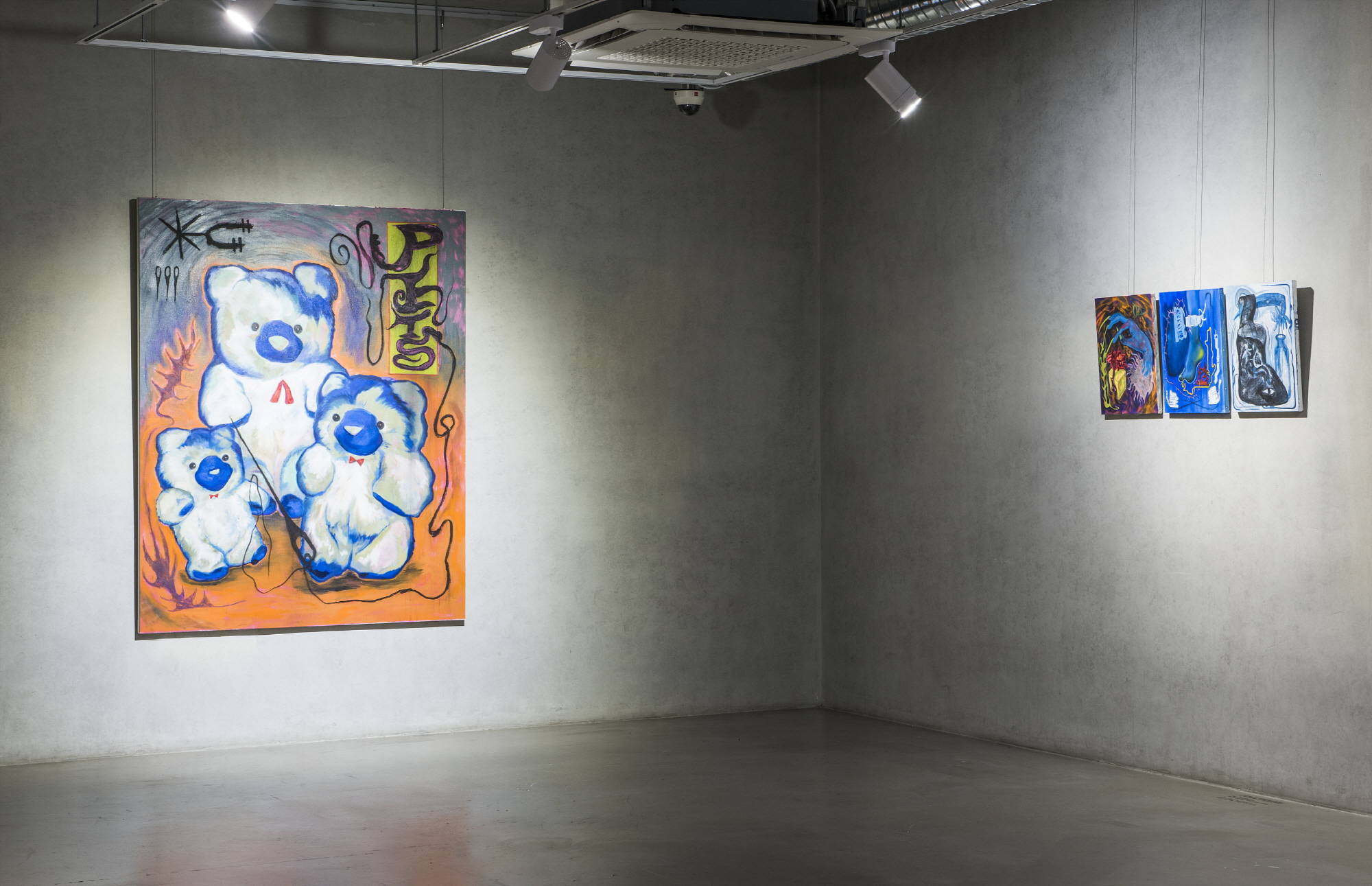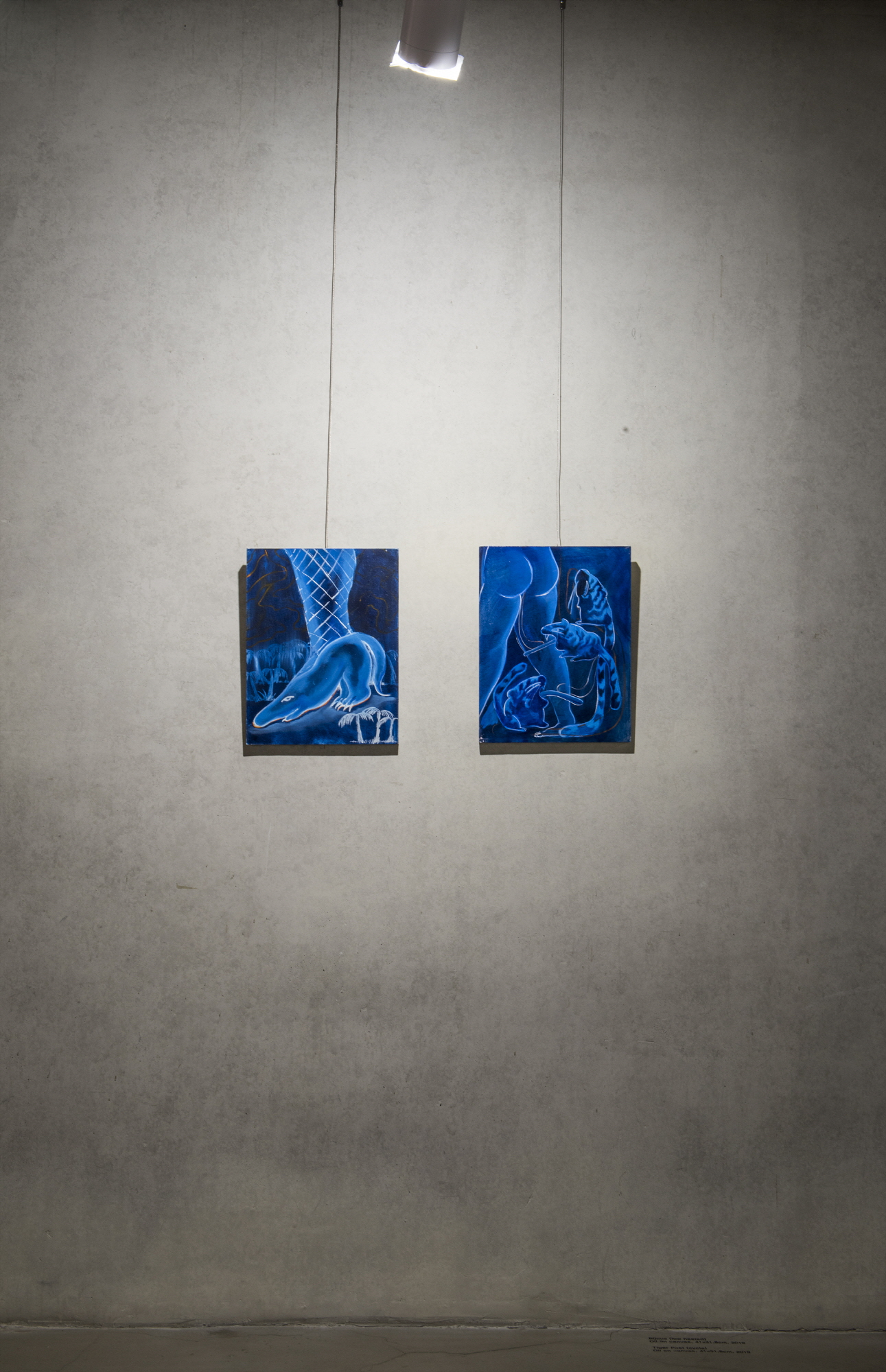Hierarchy of Beasts
Kaito Itsuki
M’VOID is a program that plans and presents exhibitions of leading artists at home and abroad who question contemporary aesthetic values while strengthening their works with insights.
ABOUT
전시 서문
수치심의 신화
그것은 ‘선언’ 같았다. 하네스, 쇠고랑, 벨트에 결박된 벌거벗은 사내의 모습이 불균형 상태로 고착되어 온 어떤 힘의 위계를 흔들어보겠다는 강력한 기호로 읽혀졌다. 그래서 작가와의 서면 인터뷰는 젠더 간의 통상적인 억압주체와 객체의 위치를 전복시키는 것인가, 라는 질문으로 시작됐다. 영국과 독일·미국·중국 등지에서 활발히 활동을 이어오고 있는 카이토 이츠키(皆藤 齋, Kaito Itsuki) 작가의 대답은 예상을 비껴갔다.
“주로 아시아권 전시 때 많이 받는 질문이다. 그보다는 신체 밖으로부터 오는 사회적 역할의 다양한 요소를 담아내려고 한다.”
여성에게 더 엄격한 예의범절이 요구되는 일본사회에서 카이토 이츠키 작가의 작품은 예의 바르지 않다. 비도덕적이고 폭력적이며 때로는 불쾌하기까지 한 도상들이 단골로 등장한다. 그런 그를 Forbes JAPAN은 지난 2018년, 차세대를 이끌어갈 30세 미만의 혁신가(‘NEXT UNDER 30’)로 선정하면서 ‘그림을 그리는 건 싸움이었다’라는 제목의 인터뷰로 소개했다. 마음 밑바닥의 뒤틀림, 결핍, 고통에 가까운 욕망 등을 정신적 비료 삼아 자신의 이야기를 단단하게 직조해 나가는 강렬한 영아티스트의 모습이었다.
그리고 2021년 2월, 일본 미술전문지 미술수첩(美術手帖, Bijutsutecho)은 도발적 취향의 이 작가를 일본작가 100인에 선정했다. 모리미술관 학예사는 ‘신화나 우화를 원형으로 한 추악하고 난해한 행위들 속에서 작가는 자아에 대한 이해를 시도해 왔다.
이 디지털 시대에, 유화로 그려진 인간상에 작가 자신과 우리의 모습이 비추어지고 있는지도 모른다’고 평했다.
세상의 이런 관심은 어떤 점이 매혹의 장치로 작동하는가에 대한 호기심을 불러온다. 칼과 낫, 선정적이면서 섬뜩한 손톱, 얼굴 없는 나신의 남성이 주요 소재다. 이와 함께 기괴한 모습의 개와 야생성을 잃은 호랑이, 서늘한 기운의 봉제인형 등 익숙함을 기이함으로 변형시킨 동물 이미지들이 등장한다. 이들의 생경스러운 조합은 밀실의 의식과도 같은 시나리오와 결합되면서 안티모럴과 수치심, 나르시시즘 등이 한데 뒤엉킨 초현실적 풍경이 된다. 신비와 혼돈의 풍경을 따라가다 보면 문득 자아의 괴물성을 자각하는 것과 같은 낯설고 불편한 경험과 마주하게 되기도 한다.
이에 대해 작가는 “현대인의 사회생활에서는 결코 보여질 수 없는 언더그라운드 콘텐츠에서 많은 영향을 받았다. 그러나 작품에 등장하는 성적, 비도덕적 이미지들은 타인과의 상호작용에 의한 것이 아니다. 그것들은 나의 내면을 향한 나선형의 방향으로만 존재한다. 폭력성도, 부도덕함도, 쾌감의 순간과 수치심 모두 나를 향하고 있다”고 설명한다. 그러면서 “타자나 사회로부터 이해될 수 없는 행위, 생산성 없는 낭비 따위로 치부될 수도 있지만 누군가에게는 인간으로 존재하기 위한 절실함의 은유일 수 있다. 예술이라는 행위도 그와 다르지 않다고 생각한다. 나만의 신화를 찾아가는 과정이기도 하다.”고 덧붙인다.
소설 ‘산월기’(山月記, 나카지마 아쓰시 中島 敦)를 모티브로 한 최근의 연작들은 자기애를 향해 더욱 치밀해진 작가의 사유를 보여준다. 일본의 교과서에 실릴 정도로 널리 알려진 이 소설에 등장하는 호랑이는 비겁한 자존심과 거만한 수치심(cowardly pride and arrogant shame)의 상징이다. 바람직한 인간성을 해치는 것으로 간주되는 이런 결함은, 그러나 작가에게는 사회와 타자로부터 부여받은 역할을 거부하는 능동적 태도로 받아들여진다. 작가는 이 지점에서 자신의 미의식의 뿌리가 결함을 끌어안는 자기애 곧 나르시시즘이라고 설명한다. 현실의 세계와 내가 부딪히는 지점에서 세상으로부터 부정적 요소로 간주되는 취약성을 기꺼이 선택한다는 것이다.
그런 이유에서 특정 젠더와 성적 폭력의 이미지가 반복적으로 다뤄지고 있음에도 억압과 불평등에 대한 분노나 연대를 향한 외침의 온도는 느껴지지 않는다. 수치심의 도상들에도 비루함이 없다. 도리어 멀쩡한 속내를 짐짓 어눌한 듯한 모습으로 가장하는 우화의 천연덕스러움이 묻어난다. 그리고 도저히 어울릴 수 없는 소재들 사이에서 파생되는 불협화음이 리드미컬한 역동성으로 작용하며 화려한 쾌감을 향해 치닫는 듯 보인다. 실제로 작가는 자신과 작품에 대해 매우 긍정적이고 쾌활하다고 자평한다. 이는 현실에서 이상을 보는 낭만성과 맞닿아 있다. 수치심과 상처의 영토에서 낭만적 자기인식을 키워나가는 방식으로 보인다.
갤러리밈 기획으로 한국에서 처음 선보이는 카이토 이츠키 작가의 작품세계는 아름답지 않다. 보편적이지도 않다. ‘야수들의 계급’ (三獣のヒエラルキー, Hierarchy of Beasts)이라는 전시 주제처럼 작가는 자신의 신화 속에 등장하는 존재들을 관찰자의 시선으로 바라보면서 독특한 내러티브를 이어 나간다. 이야기의 시작은 신화라면 으레 등장하는 초월적 영웅의 존재를 들어내고 그 자리에 수치스러움과 두려움 따위를 채워 넣는 작업이었다. 내면의 바닥을 똑바로 바라보는 용기가 전제되지 않고서는 가능하지 않은 일일 터이다.
신화란 실제로 존재하지 않기에 신비와 영원성이 가능하다. 그리고 예술가란 세상이 이해하지 못하는 어떤 것들과 싸워야 하는 존재다. 이 두가지 조합이 작가로 하여금 자신만의 신화를 엮어내게 하고 세상의 정형성으로부터 걸어나오게 했을 것이다. 문명과 야만의 구분이 시시해지고, 남성과 여성의 위치가 전복되고, 인간과 동물의 위계가 뒤섞이고, 자유와 구속의 정의가 모호해지고, 그러면서 혼돈과 질서가 사이좋게 중재되는, 이방의 이 젊은 작가가 만들어낸 신화의 풍경 앞에서 잠시 멈춰서보길 권한다. 세상 모든 가치의 잣대들로부터 한 발 물러서서 마음 속 검은 우물을 들여다보기 딱 좋은 순간이다.
김현진 (갤러리밈 전시기획자)
The Myth of Shame
It was like a ‘declaration’. The figure of a naked man tied to a harness, handcuffs, and belt was read as a strong sign of shaking the hierarchy of a certain power that had been fixed in an unequal state. So, my written interview with the artist started with the question, “Are you overturning the typical positioning of agent and object in the gender dynamic?” The answer from Itsuki Kaito(皆藤 齋), who has been active in the UK, Germany, the United States and China, was unexpected. “That’s a question I get a lot when I hold exhibitions in Asia. Rather than that, I try to capture the various elements of social roles that are transmitted from external sources to the body.”
Itsuki Kaito's work does not follow the etiquette of Japanese society, where women are required to follow strict social rules. Images that are immoral, violent, and sometimes even offensive appear often. In 2018, Forbes JAPAN selected her as one of 'NEXT UNDER 30', a group of innovators under the age of 30 who will lead the next generation, featuring an interview with her entitled ‘The act of painting was a fight.’ It conveyed the image of a passionate young artist who firmly weaves her own story, using twists, deficiency and desire which is so deep it borders on pain as a prompt.
In February 2021, Japanese art magazine Bijutsutecho(美術手帖) selected this provocative artist as one of the top 100 Japanese artists. The curator of the Mori Art Museum said, “The artist has tried to understand the self amidst ugly and esoteric acts based on the archetypes of myths and fables. In this digital age, the images of the artist and of ourselves are probably reflected in the human figures painted in oil.”
The interest Kaito’s work has generated raises the question of which types of subjects arouse the curiosity of the audience. Kaito’s main subject matters are the sword and sickle, sensational and eerie fingernails, and the naked man without a face. Along with this, animal characters such as bizarre creatures from mythology, the tiger that has lost its animal instinct and rag dolls emitting creepy energy collide with each other noisily. Their strange combination is fused with the artist's proposed scenario, which is that of consciousness in a secret room creating a surreal landscape in which the immoral, the shameful and the narcissistic are entangled together. As you delve into this mysterious and bizarre landscape of chaos, you may encounter unfamiliar and uncomfortable experiences, such as being aware of the monstrosity of the self.
The artist explains, “I was greatly influenced by the underground contents which is not visible in contemporary social life. However, the sexual and immoral images that appear in my works are not drawn from interactions with others. These exist only in direction towards my inner self. Violence, immorality, moments of pleasure and shame are all directed at me.” She adds, “These things are regarded by others or by society as incomprehensible, as wasteful due to the lack of productivity, but for some, they can be metaphors for the desperate ctions we take to exist as human beings. I think the act of creating art is no different from that. It is also a process of finding my own myths.”
Kaito’s recent series, based on “The Moon Over the Mountain” by Atsushi Nakajima, conveys more elaborate thoughts regarding narcissism. The tiger in this novel, famous enough to appear in school textbooks of Japan, is a symbol of cowardly pride and arrogant shame. These defects, which are regarded as anathema to desirable human conduct are, however, accepted by the artist as an active attitude that rejects the roles imposed by society and other people. At this point, the artist explains that the root of her aesthetic consciousness is love for oneself, i.e., narcissism that embraces such flaws. At the juncture where the real world and the ego collide, she is willing to choose her vulnerabilities, which are considered negatively by the external world.
For this reason, even though images of certain genders and sexual violence are repeatedly addressed, there seems to be no anger over oppression and inequality, nor a call for solidarity. Even the images of shame bear no trace of criticism. Rather, they show the unaffectedness and feigned ignorance of the allegory, which pretends to be inarticulate. It seems that the dissonance generated between subject matters that are unmatchable with each other is a rhythmic dynamism, rushing towards splendid jouissance. In fact, the artist claims to be very positive and cheerful about herself and her work. This relates to the romanticism of seeing the ideal in reality. It seems to be a way to develop romantic self-awareness in the territory of shame and trauma.
Itsuki Kaito's art, which is first showcased in Korea by GalleryMEME, is not beautiful nor is it universal. As in the theme of the exhibition ‘Hierarchy of Beasts’ the artist creates a unique narrative by looking at the beings that appear in her myth through the eyes of an observer. The start of this interesting story was to remove the transcendental hero that usually appears in mythology and instead fill this place with shame and fear. This would not be possible without the courage to look straight at the dark elements of oneself.
Since myths do not really exist, mystery and immortality are possible and an artist is a being who has to fight something the world does not understand. The combination of these two would have allowed the artist to weave her own myth and step out of the stereotypes of the world. In the mythical landscape created by this young artist from a foreign country, the distinction between civilization and barbarism becomes insignificant, the positions of men and women are overthrown, the hierarchies of humans and animals are mixed and the definition of freedom and bondage becomes obscure and in the meantime, chaos and order are well mediated. I hope you will stop for a moment in front of this landscape. It is a perfect moment to take a step back from the values and standards of the world and look into the black well within us.
Kim Hyunjin (Chief Curator of GalleryMEME)
카이토 이츠키 Kaito Itsuki 皆藤 齋
2019 Kyoto City University of Arts (KCUA), Painting Department, Kyoto, Japan (MFA)
2016 Tōhoku University of Art & Design (TUAD), Fine arts Department, Yamagata, Japan (BFA)
SOLO Exhibition
2021 Hierarchy of Beasts, GalleryMEME, Seoul, Korea
2020 In search of..., 14a, Hamburg, Germany
2019 たりない循獣 / Unsatidfied animals of the cycle, GINZA TSUTAYA, Tokyo, Japan
IDÉE FIXE, Tong Gallery + Project, Beijing, China
2018 Tiger Poet, CLEAR GALLERY, Tokyo, Japan
2017 THE WOMEN FROM THE GROUND, DNA, N’s art project, Osaka, Japan
Jungle-7,000,000, MORI YU GALLERY, Kyoto, Japan
Tiger Technique, KCUA, Kyoto, Japan
Others
2020 The Peter S. Reed Foundation Grant Recipient
Guangzhou Contemporary Art Fair 广州当代艺术博览会 (From Tong Gallery + Project)
2019 NADA MIAMI (From 4649, Tokyo)
2016 End of Summer, Yale Union Contemporary Art Center, Portland, US
Selected Media
2021 Bijututecho, Feb. 2021/美術手帖 2021年 2月号 ニューカマー・アーティスト100
2020 Elephant web - Hybrid Humans Run Wild in the Otherworldly Paintings of Kaito Itsuki
GLAMCULT - #132 (PARA)NORMAL Issue _ https://shop.glamcult.com/products/132-the-paranormal-issue
2019 VICE China _ http://thecreatorsproject.vice.cn/read/creator-of-the-week-009-Itsuki-Kaito
2018 Forbes Japan web _ https://forbesjapan.com/articles/detail/24355

